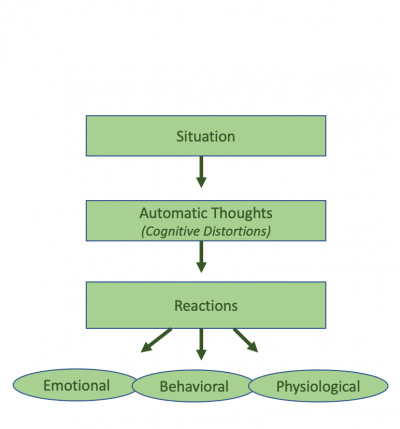Cognitive behavioral therapy (CBT) has been my main therapeutic orientation for years now. Why? Because it is AAAMAZING. I initially decided to specialize in CBT because of its robust evidence-base. But once I started seeing firsthand just how much these techniques helped my clients address their anxiety (as well as in my own personal therapy), I became extremely passionate about using it. I also started providing CBT lectures to licensed therapists and graduate students. I even share some of these techniques with my family and friends when they are experiencing anxiety. Afterall, if I know something is effective in improving the anxiety experienced by so many people, why not shout it from the rooftops?!

CBT is an action-oriented, skill-based type of therapy that is based on the cognitive model. Cognitive model?? Let me explain. We often assume that something happens (a situation or an event) and then we react directly to that situation. You missed a call from your supervisor (situation) and you feel anxious (reaction). But there is a key piece of missing information here. You aren’t feeling anxious because your supervisor called you. You are feeling anxious because of the thoughts you had in response to your supervisor calling you. This might seem like an insignificant distinction but I assure you it is quite significant. Your interpretation of things is an extremely powerful part of this whole process. Take a look at the diagram of the basic cognitive model to the right and then I will explain.
So, you missed call from your supervisor and think, 'I am going to get fired.' As a result of this thought, you start to feel anxious and overwhelmed (emotional reactions), you feel sick to your stomach (physiological reaction) and so you begin frantically looking for jobs on Indeed (behavioral reaction). This process seems pretty intuitive, right? Something happens, you have a thought and then you react. Big deal, why do we care? See, the issue is that we often just assume our thoughts are valid. Because of this, we don’t challenge our thoughts but continue on and react to them as though they are all just simple facts.
But they are NOT facts. Research shows that all people engage in what are called cognitive distortions or thinking errors. Thinking errors are inaccurate thought patterns and there are several common types (see a list). Everyone engages in thinking errors but people with anxiety tend to do it more often than those without anxiety. A key CBT intervention is examining the validity of these thoughts. Your supervisor called you and your automatic thought is that you are going to get fired. We will need to explore the validity of this thought. What is the evidence that your supervisor will fire you? Is there any evidence against this thought?
Research shows that people with anxiety tend to:
Because of this, it is especially important for people with anxiety to learn how to examine the validity of their thoughts. I can’t tell you how many times I’ve worked with clients on this and through it they come to realize either that their feared outcome was highly unlikely or that it wouldn’t be nearly as catastrophic as they assumed it would be
After explaining all of this, I want to be clear about something. CBT is not about “positive thinking.” We aren’t telling you to be positive, hope for the best and eventually you’ll feel better. No. If you have anxiety and have ever tried to just “think positive” I am sure you quickly learned that it doesn’t work.
CBT is about logical thinking. Of course, it is possible that your supervisor is, indeed, calling you in order to give you the boot. People do get fired. Anything is possible but is it probable? On rare occasions, we may find that after examining certain thoughts, that a given outcome is likely. In this case, we want to explore how you will cope with the outcome. Because, as people with anxiety tend to underestimate their ability to cope with the feared outcome, it is important to explore what you think about your ability to cope and modify any inaccurate thoughts and beliefs.
The cognitive model displayed above is a very basic overview. There is a much more complicated cognitive model that delineates the relationship between a variety of critically important factors that tend to keep that anxiety alive and well.
These factors include:
As we get deeper into treatment, we will explore all of these factors and will help you to modify inaccurate or unhelpful core beliefs, assumptions and coping mechanisms. It’s a whole thing!
CBT is a bit more structured than the traditional “talk therapy” style. It is very skill-based and action-oriented. In other words, we will be working together as a team, helping you to develop and practice new ways of thinking and behaving, both inside and outside of sessions. Like any type of therapy, you will help me set the agenda for each session- based on the current problems you are facing that you want to be addressed in session. However, we will be doing more than just talking. This isn’t a coffee chat. We will be collaboratively using cognitive and behavioral interventions to help you develop and exercise skills that you can use throughout your lifetime. My dream is to help you become your own cognitive therapist!
Below are a list of some of the things we will be doing in sessions. Note, this is not an exhaustive list!
Chesworth Counseling & Support, PLLC, © 2020.